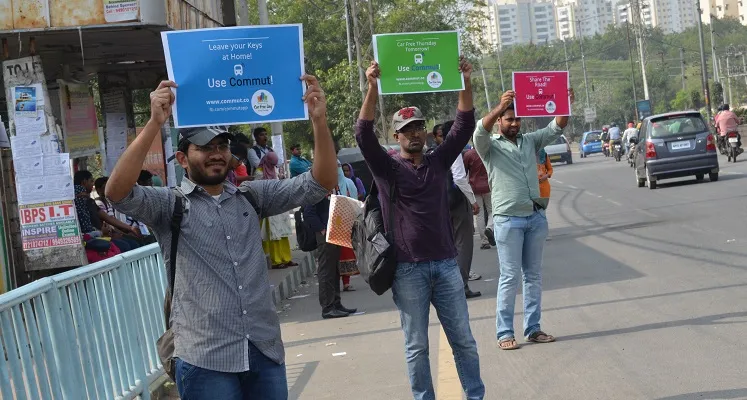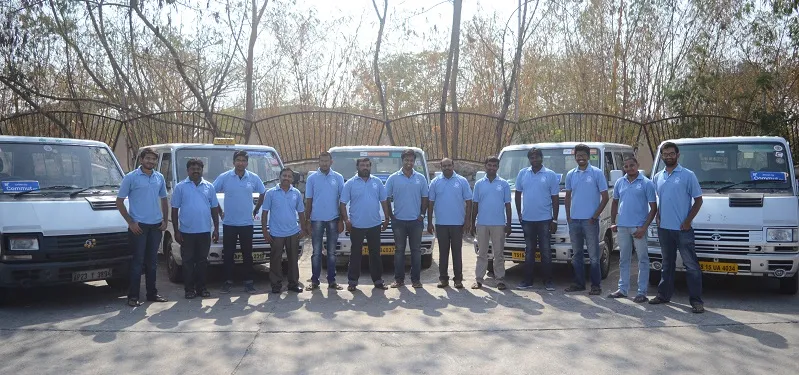Hyderabad! These 23 year olds are trying to solve the Commut-ing problem in your city
Amongst the stories of entrepreneurship, of planned moves, of dreams and desires of starting up and of leaving plush corporate jobs are a bunch of 23 year olds, who were trying to answer that question we have all asked ourselves,“What am I doing with my life?”

In fact, these were the exact words of the conversation Prasanth Garapati, 23, one of the co-founders was having with his friends.
During that conversation, another co-founder, Hemanth Jonnalagadda, 23, suggested that starting up might be the solution to their life crisis. He was already facing a problem with long waits for buses and expensive cab services while commuting to Hitech city in Hyderabad from Dilshuknagar.
Their co-founders and batch-mates from IIIT Hyderabad - Sandeep Kachavarapu, Charan Thota, Srujai Varikuti – who were also facing the same problem joined in to launch Commut, a mobile-based minibus shuttle service for daily office commuters in September, 2015.

First time lucky?
Despite it being their first venture, the company registered more than 3,000+ users in just 75 days and has taken 4,000 bookings till date.
At present, they operate in 12 areas of Hyderabad with a fleet of 17 buses; the main commuting traffic comes from areas like L.B. Nagar, Uppal, ECIL, Secundrabad and Kukatpally. Prasanth even claims that almost eight to nine of their buses run at 100 per cent occupancy, with a retention rate of almost 73 per cent. The service receives 250 requests per day primarily comprising IT employees, of whom 60 per cent are women.
Prasanth says that the team was absolutely surprised to see the percentage of women using the service and plans to introduce a live tracking system for buses. They also plan to include an in-app panic button, which sends an immediate message to the emergency contacts and nearest police stations where they can track the vehicle.
Looking at the ‘vanity metrics’, as the team defines it, the service has over 3,500 downloads; and the team is looking at launching the iOS version of the app, as well as web bookings, by next week.
The service claims to be providing point-to-point pickup, charging Rs 3 per kilometer with a guaranteed AC seat and no surge in prices with live tracking. The service accepts payments online with no need for cash transactions.
Another innovation is route optimisation, which helps buses take the shortest and most traffic-free routes on a real-time basis. ZipGo, one of their biggest competitors, is also creating their own maps in the backend, which requires more intelligence than just the information of routes with traffic. Thus, frequency is a major metric for bus shuttle services.

Shuttling to the future
The firm is also in talks with IT multinationals and other SMEs to promote their services amongst their employees. Currently, they are in talks with Deloitte from where they receive 40 per cent of their monthly business. These are not strictly partnerships but rather promotional activities that the company is pursuing to push up its customer base.
Over the next three months, Prasanth tells us the firm is hoping to scale up in Hyderabad by extending their operations to 24 areas with buses shuttling through these areas every 15 minutes.
They are also planning to increase their fleet to 150 buses adding almost 10 buses every week. Moreover, expansion to other cities is also on the cards with the co-founders planning to expand to other metros by the end of this year.
Adding to this, the firm is also working on a smart pairing feature, which will allow all the women going on a similar route to be put in one shuttle. Prasanth says this plan will materialise when they scale up the fleet. Their competitor ZipGo has already launched an exclusive bus service for women.
The firm is also looking to close their seed round of funding by February end, through well-known angel investors in the space.

YourStory take
Bus shuttling is not a new concept, with multiple players like ZipGo, Shuttl and Ola Shuttle already crowding the space. Still at a nascent stage, the sector is also facing a fair amount of ambiguity on operations.
On one hand, in December, we saw bus aggregators like in Series A while on the other end the Gurgaon government is seizing vehicles belonging to Shuttl and Ola on grounds of violation.
ZipGo also had the Bangalore RTO raiding their office over similar concerns in December with the government threatening to confiscate all the shuttles.
The co-founders have said that rather than compete with the government, they are trying to assist them or work closely with them to boost infrastructure. The firm is also constantly in touch with state transport officials for the same.
However, if allowed, there is immense scope for these aggregators in the market. With multinationals scaling down their transportation cab services for employees (because of operational costs), B2B could be a big segment for these players to tap into. Apart from Commut, Ola Shuttle is also working on a somewhat similar model. Moreover, Commut’s growth figures also show a need for these shuttle services on the ground. From a customer point of view, this might be more a comfortable option than public buses, with more safety features for women.
However, despite existing demand from the consumers, one cannot deny that the future of this industry is based on government policy, and bigger scale will not matter if the government brands the bus shuttle services as not complying with the law.
Website: www.commut.co







